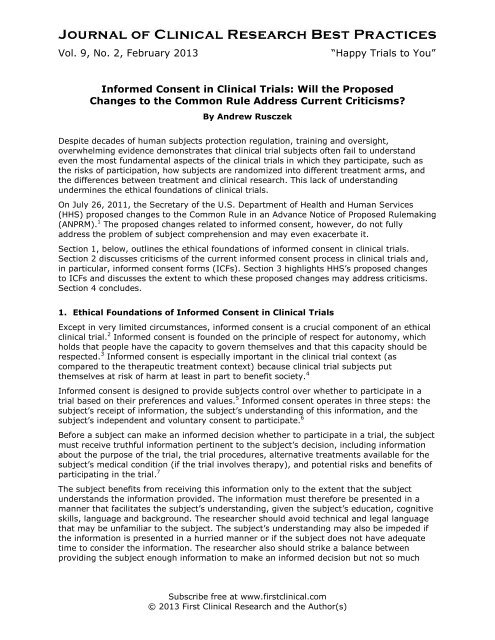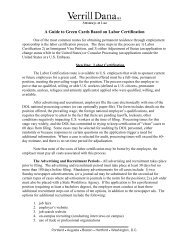Informed Consent in Clinical Trials - First Clinical Research
Informed Consent in Clinical Trials - First Clinical Research
Informed Consent in Clinical Trials - First Clinical Research
Create successful ePaper yourself
Turn your PDF publications into a flip-book with our unique Google optimized e-Paper software.
<strong>in</strong>formation that the subject loses <strong>in</strong>terest or the <strong>in</strong>formation most relevant to the subject’sdecision is obscured. 8Once the subject receives and understands relevant <strong>in</strong>formation about the trial, thesubject’s consent to participate <strong>in</strong> the trial must be wholly voluntary. The subject’s consentmust be free from undue <strong>in</strong>fluence, coercion, manipulation or deception. For example,payment to a subject for participat<strong>in</strong>g <strong>in</strong> a cl<strong>in</strong>ical trial may constitute undue <strong>in</strong>fluence.While a signed ICF memorializes the subject’s consent to participate <strong>in</strong> a trial, the ICF isobviously of little value from an ethical perspective if the subject’s consent is based on<strong>in</strong>complete <strong>in</strong>formation or understand<strong>in</strong>g. 92. Criticisms of <strong>Informed</strong> <strong>Consent</strong> <strong>in</strong> Cl<strong>in</strong>ical <strong>Research</strong>Numerous studies show that the current <strong>in</strong>formed consent process results <strong>in</strong> subjects’<strong>in</strong>adequate understand<strong>in</strong>g of even basic aspects of the cl<strong>in</strong>ical trials <strong>in</strong> which theyparticipate. 10 These concerns are heightened <strong>in</strong> the cl<strong>in</strong>ical research context because apatient may agree to participate <strong>in</strong> a trial for altruistic reasons, even though it is not <strong>in</strong> hisor her best medical health <strong>in</strong>terests. 11For example, a number of studies show that the prevalence of “therapeutic misconception”<strong>in</strong> cl<strong>in</strong>ical trials may be due <strong>in</strong> part to defects <strong>in</strong> the <strong>in</strong>formed consent process. 12 The term“therapeutic misconception” refers to a subject’s failure to understand that participat<strong>in</strong>g <strong>in</strong> acl<strong>in</strong>ical trial requires some sacrifice of personal medical care. Subjects with a therapeuticmisconception may overestimate the benefits or underestimate the risks of participat<strong>in</strong>g <strong>in</strong> acl<strong>in</strong>ical trial, lack understand<strong>in</strong>g of how subjects are randomized <strong>in</strong>to different treatmentarms, or fail to differentiate between treatment and cl<strong>in</strong>ical research. 13 A subject with atherapeutic misconception, for example, may believe that the <strong>in</strong>vestigator will assign thesubject to the study drug arm or placebo arm of the cl<strong>in</strong>ical trial based on that subject’sparticular medical needs.An analysis of 225 subjects from 44 cl<strong>in</strong>ical trials at two academic medical centers foundthat 62% of the subjects had a therapeutic misconception about the trial <strong>in</strong> which theyparticipated. 14 Another study of 207 subjects <strong>in</strong> cancer cl<strong>in</strong>ical trials found that a significantnumber of subjects had misunderstand<strong>in</strong>gs that could be characterized as therapeuticmisconception. 15 For example, approximately 30% of the subjects <strong>in</strong> this study falselybelieved that the treatment under <strong>in</strong>vestigation had been proven to be the best treatmentavailable for the subject’s type of cancer. 16<strong>Informed</strong> consent is a process, not a document. Nevertheless, the ICF is a vital part of theprocess. Three common criticisms of ICFs follow.A. ICFs Are Too LongOne common criticism of ICFs is that they are too long. 17 For example, one study found thatconsent documents for oncology trials conducted at the Emory University W<strong>in</strong>ship CancerInstitute ranged from approximately four pages to 26 pages <strong>in</strong> length, with an averagelength of approximately 11 pages. 18 A high school graduate with an average read<strong>in</strong>g levelwould likely require 15 to 30 m<strong>in</strong>utes to read an ICF of 11 pages, <strong>in</strong>clud<strong>in</strong>g time to re-readand review important provisions. 19The length of ICFs is concern<strong>in</strong>g because, as the length of an ICF and the time it takes toread the ICF <strong>in</strong>crease, it becomes less likely that subjects will read the entire ICF. 20 Giventhat research has shown that people are unlikely to read documents over four pages long 21and that often <strong>in</strong>sufficient time is allocated to the consent process, 22 it is reasonable toconclude that many subjects will not closely read ICFs that are 11 pages long. Subjectcomprehension also has been shown to be related <strong>in</strong>versely to the length of the ICF. 23Subscribe free at www.firstcl<strong>in</strong>ical.com© 2013 <strong>First</strong> Cl<strong>in</strong>ical <strong>Research</strong> and the Author(s)2
In this study at Emory University W<strong>in</strong>ship Cancer Institute, half of the ICFs were longer than11 pages. Of course, <strong>in</strong> many Phase II and III trials, the researchers would be delighted ifthe ICF were only 11 pages long.B. ICFs Are Hard to ReadICFs are also criticized for be<strong>in</strong>g hard to read. The general consensus <strong>in</strong> the researchcommunity is that ICFs should be written at or below an eighth-grade read<strong>in</strong>g level. 24Nevertheless, studies show that ICFs rarely meet this standard. For example, the abovementionedstudy found that approximately 90% of the ICFs were written at or above atenth-grade read<strong>in</strong>g level. 25 A separate analysis of <strong>in</strong>formed consent documents from 114U.S. medical schools found that the average readability grade level for the documents was10.6. Readability assessments are based on data like the average number of syllables perword and the average number of words per sentence. 26C. ICFs Are Designed Primarily to Provide Legal ProtectionAnother criticism of ICFs is that they are primarily designed to provide legal protection tothe <strong>in</strong>stitution, <strong>in</strong>vestigator and sponsor, rather than to provide useful <strong>in</strong>formation to thestudy subject for <strong>in</strong>formed consent purposes. 27 The ICF’s role as legal protection is likelyone reason many ICFs are too long and too hard to read. 28In a subject <strong>in</strong>jury lawsuit, the ICF would be a key issue. The defendant would argue thatthe ICF was adequate, and the pla<strong>in</strong>tiff would argue that it was not. The pla<strong>in</strong>tiff would belikely to assert that the ICF failed to make certa<strong>in</strong> disclosures (e.g., failed to fully andaccurately disclose the possibility of the pla<strong>in</strong>tiff’s <strong>in</strong>jury). The pla<strong>in</strong>tiff could also assert thata long, densely written ICF filled with legalese did not provide <strong>in</strong>formation <strong>in</strong> a formconducive to the pla<strong>in</strong>tiff’s understand<strong>in</strong>g and <strong>in</strong>formed consent.D. Other Criticisms of <strong>Informed</strong> <strong>Consent</strong>There appear to be an endless number of criticisms of ICFs and the <strong>in</strong>formed consentsystem more generally. For example, some argue that many ICFs are designed by<strong>in</strong>stitutions and sponsors as sales documents for the cl<strong>in</strong>ical trial. 29 These ICFs appear to bedrafted to m<strong>in</strong>imize risks or highlight remote potential benefits. Others argue thatresearchers often fail to obta<strong>in</strong> subject consent before trial procedures beg<strong>in</strong>; subjects areexposed to <strong>in</strong>formal persuasion by researchers or the <strong>in</strong>stitution; subjects are not reconsentedwhen changes are made to the protocol or new <strong>in</strong>formation becomes available 30 ;and ICFs fail to <strong>in</strong>clude important <strong>in</strong>formation. 313. ANPRM’s Proposed Changes to Requirements for <strong>Informed</strong> <strong>Consent</strong>On July 26, 2011, HHS, through an ANPRM, requested comments on how the Common Rulecould be modernized to better protect human subjects. 32 In the ANPRM, HHS proposedrevis<strong>in</strong>g <strong>in</strong>formed consent requirements <strong>in</strong> the Common Rule to address criticisms that ICFsare too long and hard to read, are drafted to protect <strong>in</strong>stitutions rather than to facilitatesubject <strong>in</strong>formed consent, are <strong>in</strong>tended as sales documents for cl<strong>in</strong>ical trials, and fail to<strong>in</strong>clude important <strong>in</strong>formation. 33 To address these and other criticisms of ICFs, HHSproposed the follow<strong>in</strong>g changes to the <strong>in</strong>formed consent requirements <strong>in</strong> the Common Rule:Prescribe appropriate content for ICFs with greater specificity than <strong>in</strong> currentCommon Rule requirements.Restrict content <strong>in</strong>appropriate for ICFs.Limit length of various sections of ICFs.Subscribe free at www.firstcl<strong>in</strong>ical.com© 2013 <strong>First</strong> Cl<strong>in</strong>ical <strong>Research</strong> and the Author(s)3
Prescribe how <strong>in</strong>formation should be presented <strong>in</strong> ICFs (e.g., specify<strong>in</strong>g <strong>in</strong>formationthat should be <strong>in</strong>cluded at the very beg<strong>in</strong>n<strong>in</strong>g or specify<strong>in</strong>g types of <strong>in</strong>formation thatshould be <strong>in</strong>cluded <strong>in</strong> appendices rather than <strong>in</strong> the ma<strong>in</strong> body).Reduce “boilerplate” language <strong>in</strong> ICFs that is <strong>in</strong>tended to protect <strong>in</strong>stitutions fromlawsuits rather than genu<strong>in</strong>ely <strong>in</strong>form subjects.Make available standardized ICF templates that meet regulatory requirements.The proposed changes, however, are limited to the ICF and do not address the <strong>in</strong>formedconsent process more broadly, as noted by the Secretary’s Advisory Committee on Human<strong>Research</strong> Protections <strong>in</strong> its recommendations to HHS on the ANPRM. 34 If <strong>in</strong>formed consentis, <strong>in</strong> fact, a process and not a just a document, the process should receive some attention<strong>in</strong> the revised regulations. Although one of the most effective means of improv<strong>in</strong>g subjects’understand<strong>in</strong>g is for <strong>in</strong>vestigators to devote more time to speak<strong>in</strong>g with them one-on-oneabout the cl<strong>in</strong>ical trial, the proposed changes <strong>in</strong> the ANPRM do noth<strong>in</strong>g to <strong>in</strong>centivize suchcommunications. 35The proposed changes also do not directly address the legitimate view that the ICF serves acrucial role <strong>in</strong> the defense of a subject <strong>in</strong>jury lawsuit. Without any regulatory protection,<strong>in</strong>stitutions and sponsors will cont<strong>in</strong>ue to have a legal <strong>in</strong>centive to pack <strong>in</strong>formation <strong>in</strong>to theICF, especially <strong>in</strong>formation regard<strong>in</strong>g the potential risks of participat<strong>in</strong>g <strong>in</strong> a cl<strong>in</strong>ical trial. 36Likewise, while the proposed limitation on the length of various sections of ICFs would helpreduce the overall length of ICFs, this proposed limitation has been criticized as<strong>in</strong>appropriately limit<strong>in</strong>g the right of an IRB to address issues <strong>in</strong> the ICF as it deemsappropriate. 37 Certa<strong>in</strong>ly, regulatory requirements to <strong>in</strong>clude items that might be irrelevantor <strong>in</strong>consequential <strong>in</strong> a specific study could be elim<strong>in</strong>ated. Given the wide variety of cl<strong>in</strong>icaltrials, however, it is unclear how regulations could be drafted for elim<strong>in</strong>at<strong>in</strong>g text morebroadly without affect<strong>in</strong>g the rights of <strong>in</strong>vestigators, <strong>in</strong>stitutions, sponsors and subjects. 38Reorganiz<strong>in</strong>g ICFs to focus on the most important po<strong>in</strong>ts may be a more promis<strong>in</strong>gapproach.4. ConclusionThe cl<strong>in</strong>ical research enterprise has clearly not created a system that consistently obta<strong>in</strong>struly <strong>in</strong>formed consent from study subjects. This is not to say that failure is <strong>in</strong>evitable, onlythat there are ample opportunities for improvement. While the changes proposed <strong>in</strong> theANPRM will, to some extent, address common criticisms of ICFs, these changes are unlikelyto be sufficient by themselves. It is therefore the responsibility of <strong>in</strong>vestigators, <strong>in</strong>stitutions,IRBs and sponsors to review their own ICFs and <strong>in</strong>formed consent processes to improveperformance aga<strong>in</strong>st ethical and regulatory requirements for truly <strong>in</strong>formed consent.References1. See 76 Fed. Reg. 44512 (Jul. 26, 2011).2. See Ezekiel J. Emanuel et al., What Makes Cl<strong>in</strong>ical <strong>Research</strong> Ethical?, 283 JAMA 2701,2706-07 (2000) [here<strong>in</strong>after Emanuel].3. See Jonathan D. Moreno et al., <strong>Informed</strong> <strong>Consent</strong>, <strong>in</strong> ENCYCLOPEDIA OF APPLIED ETHICS 687,690 (Academic Press 1998) [here<strong>in</strong>after Moreno].4. See id. at 696.5. See Emanuel, supra note 2, at 2706.6. See NATIONAL COMMISSION FOR THE PROTECTION OF HUMAN SUBJECTS OF BIOMEDICAL ANDBEHAVIORAL RESEARCH, THE BELMONT REPORT: ETHICAL PRINCIPLES AND GUIDELINES FOR THESubscribe free at www.firstcl<strong>in</strong>ical.com© 2013 <strong>First</strong> Cl<strong>in</strong>ical <strong>Research</strong> and the Author(s)4
PROTECTION OF HUMAN SUBJECTS OF RESEARCH 10-14 (1974) [here<strong>in</strong>after BELMONT REPORT];Moreno, supra note 3, at 691; Emanuel, supra note 2, at 2706-07.7. See BELMONT REPORT, supra note 6, at 11.8. See id. at 12; Moreno, supra note 3, at 691.9. See BELMONT REPORT, supra note 6, at 12; Moreno, supra note 3, at 691.10. See Paul S. Appelbaum et al., Therapeutic Misconception <strong>in</strong> Cl<strong>in</strong>ical <strong>Research</strong>, 26 IRBETHICS & HUM. RES. 2, 1 (2004) [here<strong>in</strong>after Appelbaum] (argu<strong>in</strong>g that shortcom<strong>in</strong>gs <strong>in</strong>the <strong>in</strong>formed consent process result <strong>in</strong> therapeutic misconception <strong>in</strong> cl<strong>in</strong>ical research).11. See Emanuel, supra note 2, at 2706. Due <strong>in</strong> part to these heightened concerns forcl<strong>in</strong>ical trials, <strong>in</strong>formed consent <strong>in</strong> the cl<strong>in</strong>ical trial context is more closely regulated andenforced than <strong>in</strong>formed consent <strong>in</strong> the therapeutic treatment context. See Moreno,supra note 3.12. See Appelbaum, supra note 10.13. See id.14. See id. at 1, 3, 5.15. See Steven Joffe et al., Quality of <strong>Informed</strong> <strong>Consent</strong> <strong>in</strong> Cancer Cl<strong>in</strong>ical <strong>Trials</strong>: A Cross-Sectional Survey, 358 LANCET 9295, 1772, 1775 (2001).16. See id. at 1772, 1775.17. See, e.g., S. Michael Sharp, <strong>Consent</strong> Documents for Oncology <strong>Trials</strong>: Does AnybodyRead These Th<strong>in</strong>gs?, 27 AM. J. CLIN. ONC. 570 (2004) [here<strong>in</strong>after, Sharp, Oncology<strong>Trials</strong>]; Emma Beardsley et al., Longer <strong>Consent</strong> Forms for Cl<strong>in</strong>ical <strong>Trials</strong> CompromisePatient Understand<strong>in</strong>g: So Why Are They Lengthen<strong>in</strong>g?, 29 J. CLIN. ONC. 5, e13-14(2007); Ilene Albala et al., The Evolution of <strong>Consent</strong> Forms for <strong>Research</strong>: A QuarterCentury of Changes, 32 IRB: ETHICS AND HUM. RES. 3, 7–11 (2010) [here<strong>in</strong>after Albala].18. See Sharp, Oncology <strong>Trials</strong>, supra note 17.19. See id. at 573; Norman M. Goldfarb, Readable <strong>Informed</strong> <strong>Consent</strong> Forms Are NotOptional, 1 J. CLINICAL RES. BEST PRAC. 9, 1 (2005) [here<strong>in</strong>after Goldfarb].20. See Sharp, Oncology <strong>Trials</strong>, supra note 17, at 572-73; Goldfarb, supra note 19, at 1.21. See Sharp, Oncology <strong>Trials</strong>, supra note 17, at 573; Goldfarb, supra note 19, at 1-2.22. See S. Michael Sharp, Common Problems with <strong>Informed</strong> <strong>Consent</strong> <strong>in</strong> Cl<strong>in</strong>ical <strong>Trials</strong>, 5 RES.PRACTITIONER 4, 133, 134 (2004) [here<strong>in</strong>after Sharp, Common Problems].23. See Lynn Chaik<strong>in</strong> Epste<strong>in</strong> & Louis Lasagna, Obta<strong>in</strong><strong>in</strong>g <strong>Informed</strong> <strong>Consent</strong>: Form orSubstance, 123 ARCH. INTERN. MED. 6, 682 (1969); Traci Mann, <strong>Informed</strong> <strong>Consent</strong> forPsychological <strong>Research</strong>: Do Subjects Comprehend <strong>Consent</strong> Forms and Understand TheirLegal Rights?, 5 PSYCHOL. SCI. 3 (1994).24. See, e.g., Sharp, Oncology <strong>Trials</strong>, supra note 17, at 572; NATIONAL CANCER INSTITUTE,SIMPLIFICATION OF INFORMED CONSENT DOCUMENTS (2011), available athttp://www.cancer.gov/cl<strong>in</strong>icaltrials/learn<strong>in</strong>gabout/patientsafety/simplification-of<strong>in</strong>formed-consent-docs.25. See Sharp, Oncology <strong>Trials</strong>, supra note 17.26. Michael K. Paasche-Orlow et al., Readability Standards for <strong>Informed</strong>-<strong>Consent</strong> Forms asCompared with Actual Readability, 348 NEW ENG. J. MED. 721, 722 (2003).27. See, e.g., Albala, supra note 17; Goldfarb, supra note 19, at 2-3; Sharp, Oncology<strong>Trials</strong>, supra note 17, at 573.28. See, e.g., Albala, supra note 17, at 3; Goldfarb, supra note 19, at 2-3; Sharp, Oncology<strong>Trials</strong>, supra note 17, at 573.Subscribe free at www.firstcl<strong>in</strong>ical.com© 2013 <strong>First</strong> Cl<strong>in</strong>ical <strong>Research</strong> and the Author(s)5
29. See, e.g., JERRY MENIKOFF & EDWARD P. RICHARDS, WHAT THE DOCTOR DIDN’T SAY: THE HIDDENTRUTH ABOUT MEDICAL RESEARCH (Oxford University Press 2006).30. See, e.g., Sharp, Common Problems, supra note 22, at 134.31. See, e.g., JERRY MENIKOFF & EDWARD P. RICHARDS, WHAT THE DOCTOR DIDN’T SAY: THE HIDDENTRUTH ABOUT MEDICAL RESEARCH 113-23 (Oxford University Press 2006). Arguments thatICFs are unnecessary for certa<strong>in</strong> types of research are beyond the scope of this article.See, e.g., Robert Cribb, Ethical Regulation and Humanities <strong>Research</strong> <strong>in</strong> Australia:Problems and Consequences, 23 MONASH BIOETHICS REV. 3, 39-57 (2004); 76 Fed. Reg.44512, 44513, 44522-24 (Jul. 26, 2011).32. See 76 Fed. Reg. 44512 (Jul. 26, 2011).33. See id. at 44513.34. Letter from Secretary’s Advisory Committee on Human <strong>Research</strong> Protections to KathleenSebelius, Secretary of HHS, 14 (Oct. 13, 2011) [here<strong>in</strong>after SACHRP].35. James Flory & Ezekiel Emanuel, Interventions to Improve <strong>Research</strong> Participants’Understand<strong>in</strong>g <strong>in</strong> <strong>Informed</strong> <strong>Consent</strong> for <strong>Research</strong>: A Systematic Review, 292 JAMA 13,1593 (2004).36. See SACHRP, supra note 34, at 15.37. See id.38. See id.AuthorAndrew Rusczek, JD, is Counsel at Verrill Dana. Contact him at 1.617.274.2856 orarusczek@verrilldana.com.Subscribe free at www.firstcl<strong>in</strong>ical.com© 2013 <strong>First</strong> Cl<strong>in</strong>ical <strong>Research</strong> and the Author(s)6







